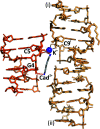Right-handed Z-DNA at ultrahigh resolution: a tale of two hands and the power of the crystallographic method
- PMID: 36762859
- PMCID: PMC9912920
- DOI: 10.1107/S2059798322011937
Right-handed Z-DNA at ultrahigh resolution: a tale of two hands and the power of the crystallographic method
Abstract
The self-complementary L-d(CGCGCG)2 purine/pyrimidine hexanucleotide was crystallized in complex with the polyamine cadaverine and potassium cations. Since the oligonucleotide contained the enantiomeric 2'-deoxy-L-ribose, the Z-DNA duplex is right-handed, as confirmed by the ultrahigh-resolution crystal structure determined at 0.69 Å resolution. Although the X-ray diffraction data were collected at a very short wavelength (0.7085 Å), where the anomalous signal of the P and K atoms is very weak, the signal was sufficiently outstanding to clearly indicate the wrong hand when the structure was mistakenly solved assuming the presence of 2'-deoxy-D-ribose. The electron density clearly shows the entire cadaverinium dication, which has an occupancy of 0.53 and interacts with one Z-DNA duplex. The K+ cation, with an occupancy of 0.32, has an irregular coordination sphere that is formed by three OP atoms of two symmetry-related Z-DNA duplexes and one O5' hydroxyl O atom, and is completed by three water sites, one of which is twofold disordered. The K+ site is complemented by a partial water molecule, the hydrogen bonds of which have the same lengths as the K-O bonds. The sugar-phosphate backbone assumes two conformations, but the base pairs do not show any sign of disorder.
Keywords: 2′-deoxy-l-ribose; Z-DNA; anomalous signal; biogenic polyamines; biological potassium complex; cadaverinium cation; dual-conformation backbone; handedness.
open access.
Figures



Similar articles
-
Crystal structure of Z-DNA in complex with the polyamine putrescine and potassium cations at ultra-high resolution.Acta Crystallogr B Struct Sci Cryst Eng Mater. 2021 Jun 1;77(Pt 3):331-338. doi: 10.1107/S2052520621002663. Epub 2021 May 6. Acta Crystallogr B Struct Sci Cryst Eng Mater. 2021. PMID: 34096514 Free PMC article.
-
Ultrahigh-resolution centrosymmetric crystal structure of Z-DNA reveals the massive presence of alternate conformations.Acta Crystallogr D Struct Biol. 2016 Nov 1;72(Pt 11):1203-1211. doi: 10.1107/S205979831601679X. Epub 2016 Oct 28. Acta Crystallogr D Struct Biol. 2016. PMID: 27841753
-
High-resolution crystal structure of Z-DNA in complex with Cr(3+) cations.J Biol Inorg Chem. 2015 Apr;20(3):595-602. doi: 10.1007/s00775-015-1247-5. Epub 2015 Feb 17. J Biol Inorg Chem. 2015. PMID: 25687556 Free PMC article.
-
Ultrahigh-resolution crystal structures of Z-DNA in complex with Mn(2+) and Zn(2+) ions.Acta Crystallogr D Biol Crystallogr. 2013 Jun;69(Pt 6):1180-90. doi: 10.1107/S0907444913007798. Epub 2013 May 16. Acta Crystallogr D Biol Crystallogr. 2013. PMID: 23695262
-
Crystal structures of A-DNA duplexes.Biopolymers. 1997;44(1):45-63. doi: 10.1002/(SICI)1097-0282(1997)44:1<45::AID-BIP4>3.0.CO;2-#. Biopolymers. 1997. PMID: 9097733 Review.
Cited by
-
Mirror-Image RNA: A Right-Handed Z-Form RNA and Its Ligand Complex.Molecules. 2024 Oct 16;29(20):4900. doi: 10.3390/molecules29204900. Molecules. 2024. PMID: 39459268 Free PMC article.
-
Biological Catalysis and Information Storage Have Relied on N-Glycosyl Derivatives of β-D-Ribofuranose since the Origins of Life.Biomolecules. 2023 Apr 30;13(5):782. doi: 10.3390/biom13050782. Biomolecules. 2023. PMID: 37238652 Free PMC article. Review.
References
-
- An, J., Choi, J., Hwang, D., Park, J., Pemble, C. W., Duong, T. H. M., Kim, K.-R., Ahn, H., Chung, H. S. & Ahn, D.-R. (2020). Chem. Commun. 56, 2186–2189. - PubMed
-
- Anderson, D. J., Reischer, R. J., Taylor, A. J. & Wechter, W. J. (1984). Nucleosides Nucleotides, 3, 499–512.
MeSH terms
Substances
Grants and funding
LinkOut - more resources
Full Text Sources
Research Materials
Miscellaneous

